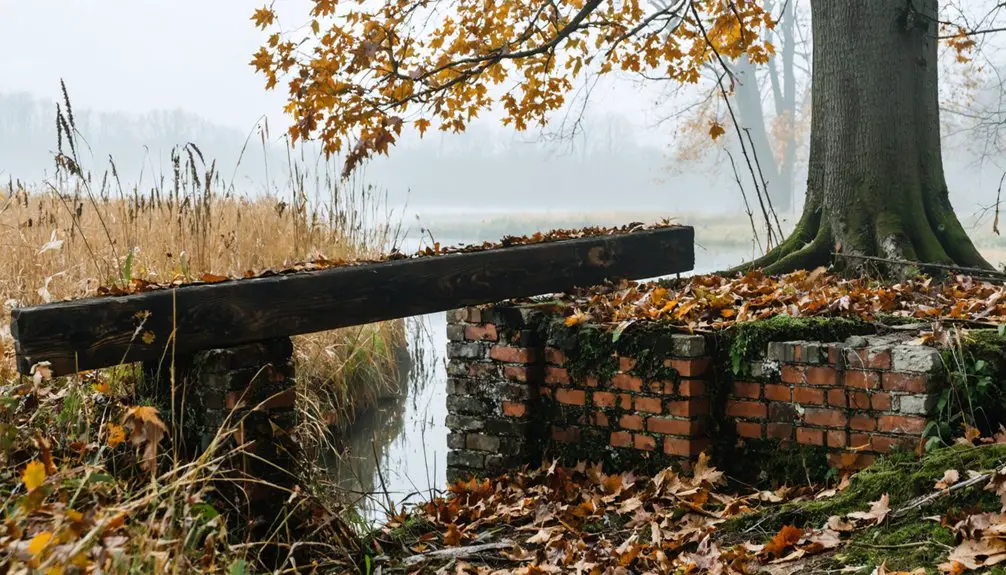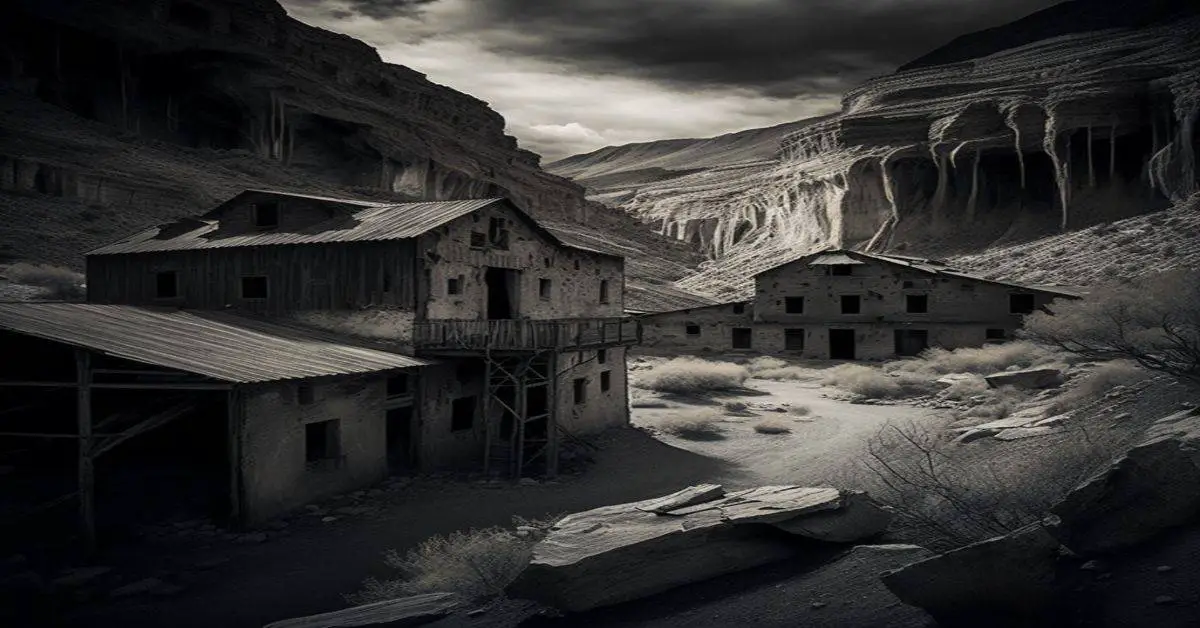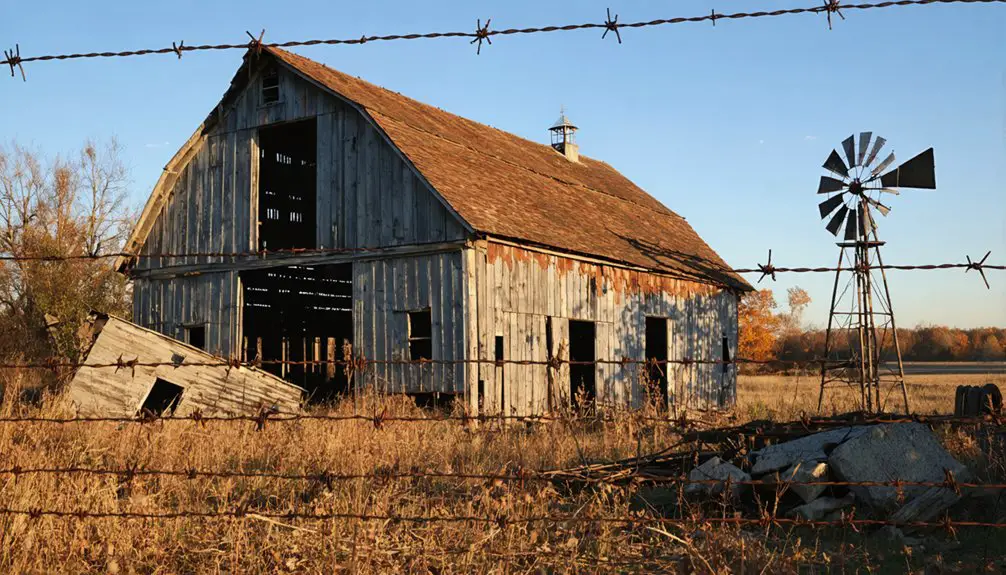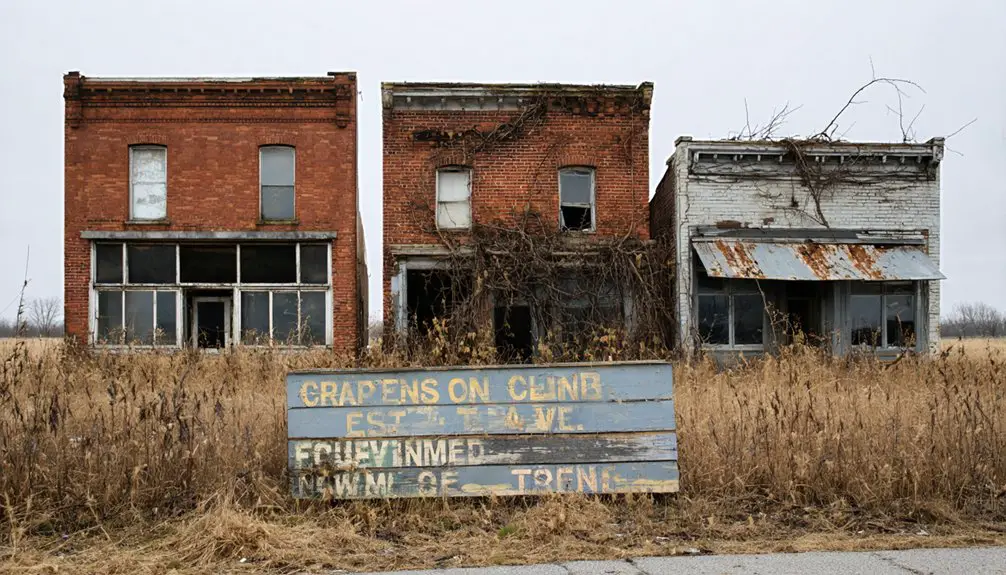You’ll find Providence, Ohio’s haunting remains along the Miami and Erie Canal, where a bustling port town thrived from 1836 to 1854. Peter Manor’s trading empire and sawmill established this strategic settlement, but devastating events, including an 1846 fire and deadly cholera epidemic, transformed it into a ghost town. Today, Providence Metropark preserves Lock 44, the gristmill, and other 19th-century structures where lantern-lit tours reveal the town’s dramatic past and unexplained mysteries.
Key Takeaways
- Providence, Ohio was a thriving canal town established in 1836 that declined after multiple disasters and the rise of railroad transportation.
- A devastating fire in 1846 destroyed the business district, followed by a deadly cholera epidemic in 1854 that accelerated its decline.
- The town’s economy relied heavily on the Miami and Erie Canal, with Peter Manor’s trading empire and mills being central features.
- Providence transformed from a bustling port town to a ghost town during the mid-1800s as canal commerce diminished and disasters struck.
- The site now serves as a historical preservation area, featuring remnants of canal infrastructure and the historic Isaac Ludwig Mill.
The Rise of a Canal Town (1836-1845)
Three key factors propelled Providence’s rapid ascent as a canal town between 1836 and 1838. First, its strategic location at the foot of the Maumee River rapids made it ideal for canal commerce.
Second, the town’s incorporation into Lucas County brought formal governance, leading to the platting of 80 lots and five streets north of the canal lock.
Third, the Miami and Erie Canal‘s arrival sparked unprecedented development. The impressive Lock #44 still stands today as a testament to the town’s canal heritage.
You’ll find evidence of the town’s meteoric rise in its swift construction of essential infrastructure. Hotels, warehouses, and stores emerged to serve the surge of traders and settlers. The first election was held at Peter Minor’s house in 1836, establishing the township’s official governance structure.
The canal’s presence triggered significant population shifts as workers and merchants flocked to Providence, transforming it into a bustling hub for fur trading, timber shipping, and westward expansion.
Peter Manor’s Legacy and Early Settlement
You’ll find Peter Manor’s influence on Providence began through his successful fur trading enterprise, which he established after receiving 643 acres from Chief Tondoganie in 1808.
His early sawmill along the Maumee River marked the first industrial development in Providence Township, creating a foundation for the region’s economic growth.
Manor’s strategic vision for Providence emerged as he platted the town in 1835, positioning it to capitalize on both river trade and the upcoming Miami-Erie Canal’s opportunities.
After Manor’s death, Isaac R. Ludwig completed construction of the mill in 1849, continuing the industrial legacy of Providence.
The Irish and German immigrants began working on the canal’s construction in 1838, bringing new economic opportunities to the region.
Manor’s Trading Empire Grows
Peter Manor, a French-Canadian fur trader born around 1778, built a flourishing commercial empire in northwest Ohio that would shape the region’s early development. Through strategic trading partnerships with the Odawa people, particularly Chief Tondoganie, Manor secured 643 acres near the Maumee River where he’d establish Providence.
You’ll find Manor’s economic influence extended far beyond fur trading. He diversified his operations to include sawmills and established essential water rights along the Miami-Erie Canal.
When the state claimed his original mill through eminent domain in 1838, Manor adapted by rebuilding improved facilities. His trading strategies evolved to serve both Native American and settler communities, offering important goods while leveraging the canal’s transportation advantages. Manor’s leadership and business acumen helped maintain quality of life that distinguished Providence from typical canal towns. His legacy lives on through his 1845 house that still stands overlooking the Maumee River.
This helped transform Providence into a significant commercial hub during the canal era.
Early Mill Construction Impact
Building upon Manor’s commercial success, the establishment of his first sawmill in 1822 marked a turning point for Providence’s development.
You’ll find that Manor’s strategic placement of the mill at the junction of river routes maximized both water power and trade access, demonstrating his keen business sense.
When the Miami & Erie Canal construction forced Manor to surrender his original mill in 1838, he shrewdly negotiated perpetual water rights that would shape Providence’s industrial future.
This legal guarantee guaranteed continued mill technology advancement, even after his death in 1849.
The Providence Dam’s construction in 1840 further solidified the area’s milling potential by regulating water flow.
Manor’s foresight in securing these water rights proved invaluable, as it enabled future owners to upgrade from traditional waterwheels to more efficient turbine systems.
The land later became home to the Isaac Ludwig Mill, which transformed from a sawmill to a gristmill in the 1880s.
The mill continued operations for nearly a century until 1970, serving as both a sawmill and flour mill for the local community.
Settlement Vision Takes Shape
In 1835, the vision for Providence took shape when Manor meticulously platted 80 lots and five streets north of the Maumee River canal lock, establishing what would become a strategic settlement at the foot of the rapids.
You’ll find that Manor’s urban planning reflected careful settlement strategies, positioning the town to capitalize on essential canal traffic and trade opportunities.
Manor’s influence extended beyond the initial layout when his house became the site of Providence Township’s first election in 1836, marking a significant step in local governance.
Though he wouldn’t live to see his complete vision realized, dying during his mill’s reconstruction, Manor’s blueprint attracted stores, hotels, and warehouses that supported westward migration, the fur trade, and timber transport, making Providence a promising transportation hub in Lucas County.
Like the nearby town of Austerlitz that emerged during the Miami & Erie Canal construction, Providence aimed to establish itself as a vital waterway stop.
The town’s name choice reflected a growing trend of establishing New Providence settlements across the expanding American frontier.
Life Along the Miami & Erie Canal
Life along the Miami & Erie Canal thrived as a vibrant cultural tapestry during the mid-19th century, when towns like Providence emerged as bustling centers of commerce and social exchange.
You’d find canal boats stretching up to 80 feet long, pulled by mules or horses at a steady 4-5 mph along the towpath, carrying both goods and travelers between Cincinnati and Toledo.
The waterway transformed daily life, as immigrant labor, especially German-Americans, shaped the cultural landscape.
You’d witness these workers crossing the canal daily, establishing communities like “Over the Rhine” while maintaining the complex system of 103 locks and 19 aqueducts.
Canal commerce brought unprecedented prosperity, connecting you to raw materials, finished goods, and weekly passenger traffic that reached 1,000 people between Cincinnati and Dayton by 1832.
The Devastating Fire of 1846
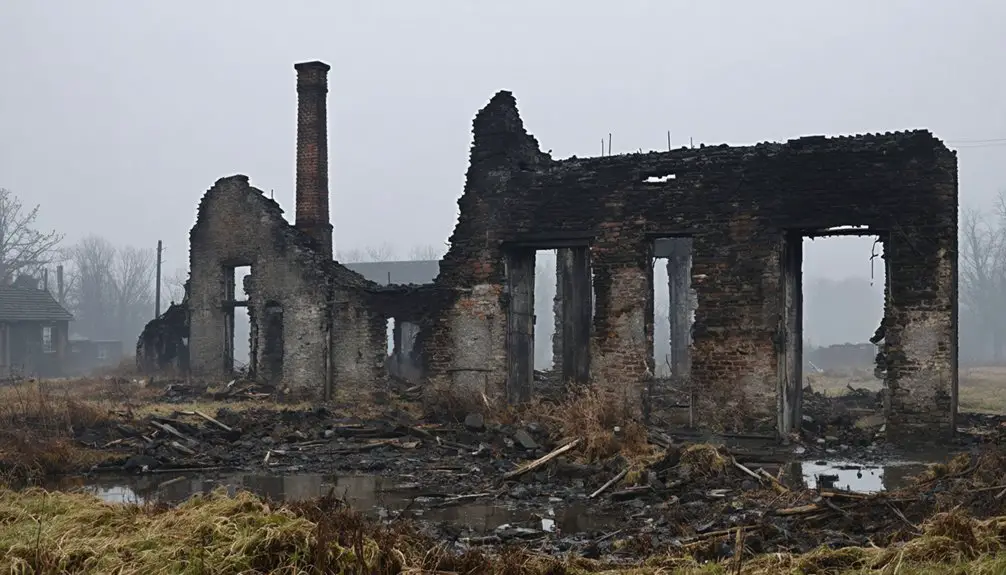
The 1846 fire in Providence, Ohio ravaged the town’s business district, destroying essential commercial buildings that served both canal traffic and local settlers.
You’ll find that the destruction dealt a severe blow to Providence’s economic foundation, with stores, hotels, and warehouses reduced to ashes during this catastrophic event.
While some residents like Peter Manor attempted to rebuild, his death in 1847 during mill reconstruction efforts symbolized the broader struggles the community faced in its recovery from the devastating blaze.
Fire’s Initial Impact
Devastating Providence’s bustling canal town economy, the 1846 fire began in the business district and quickly spread through the settlement’s wooden structures.
The fire aftermath claimed multiple lives, including two men who perished from a powder store explosion, a toddler killed instantly, and a 13-year-old boy who died after being rescued from a creek.
You’ll find the destruction was particularly severe near the Miami & Erie Canal, where Peter Manor’s crucial mills sustained heavy damage.
Despite initial community resilience and attempts to rebuild, the lack of modern firefighting capabilities left Providence vulnerable.
The blaze destroyed crucial infrastructure and businesses, disrupting the trade networks that had made the canal town prosperous.
This catastrophic event marked the beginning of Providence’s decline from a thriving settlement to eventual abandonment.
Business District Destruction
When flames engulfed Providence’s bustling business district in 1846, they tore through a compact commercial hub of wooden structures laid out across five streets with 88 carefully plotted parcels.
You’d have witnessed the destruction of essential trade establishments that had flourished along the Miami & Erie Canal route, devastating the town’s economic core.
Without advanced firefighting capabilities, the blaze consumed the wooden buildings rapidly, crushing hopes for immediate business revival.
The impact hit hardest when Peter Manor, the original mill owner, couldn’t complete rebuilding efforts before his death in 1847.
The mills’ transfer to Isaac and Christenia Ludwig signaled the struggle for economic resilience.
The loss of crucial infrastructure left Providence at a severe disadvantage compared to neighboring towns, permanently altering its commercial landscape.
Community Recovery Efforts
Following the catastrophic 1846 fire, Providence’s residents mobilized to salvage their community through focused rebuilding initiatives. Peter Manor led the initial recovery by starting mill reconstruction, but his death in 1847 transferred this vital responsibility to Isaac and Christenia Ludwig.
Despite showing remarkable community resilience, Providence’s rebuilding strategies faced mounting challenges. You’ll find that while some residential and service buildings were restored, the absence of organized firefighting infrastructure left the town vulnerable.
The community’s recovery efforts were further hampered by a devastating cholera epidemic in the early 1850s. Without a railroad station and facing declining canal traffic, Providence’s attempts at economic diversification fell short.
The township’s governance and social activities gradually shifted away from the canal area, signaling the community’s irreversible transformation.
Tragedy Strikes: The Cholera Epidemic

The tranquil canal town of Providence, Ohio faced its darkest hour in 1854 as cholera swept through the community, claiming countless lives and permanently altering its trajectory.
You’ll find that Providence’s public health response, like many Ohio towns of the era, proved woefully inadequate against this devastating disease. Officials didn’t understand that contaminated water, not “bad air,” spread the illness through the bustling canal port.
The epidemic hit Providence particularly hard, striking a community already weakened by a devastating fire in 1846.
Living conditions near the docks, with poor sanitation and unclean water, created perfect conditions for cholera’s rapid spread.
While St. Patrick’s Catholic Church still stands as a symbol of Providence’s resilience, the 1854 outbreak marked the beginning of the town’s decline toward ghost town status.
From Bustling Port to Fading Memory
Despite its promising start as a strategic port along the Miami and Erie Canal, Providence’s transformation into a ghost town unfolded through a series of devastating setbacks in the mid-1800s.
You’ll find that canal commerce, once the lifeblood of this bustling port town, began to wane as railroads emerged as America’s preferred transportation method. Without a railroad station of its own, Providence couldn’t adapt to the changing times.
The town’s decline accelerated after several crushing blows: a destructive fire in 1846 that ravaged the business district, the death of founder Peter Manor in 1847, and a deadly cholera outbreak in the early 1850s.
Legends and Lore of Providence
While Providence’s physical structures faded into history, its spiritual legacy took root in 1847 when spiritualist leader John O. Wattles and his followers established their presence in the declining settlement.
As Providence’s buildings crumbled, spiritualist John O. Wattles and his followers breathed new mystical life into the fading settlement.
Their spiritualist influence shaped the town’s identity through séances and spirit communications, leaving an indelible mark that persists today.
You’ll find haunting narratives woven throughout Providence’s story, from tales of shadowy figures near the canal to unexplained phenomena around historic cemeteries.
The tragic backdrop of cholera epidemics and devastating fires adds depth to these supernatural accounts.
Each October, you can experience these stories firsthand during the Ghosts of Providence Lantern Tour, where lantern-lit walks bring the past to life.
This blend of documented history and spectral lore has transformed Providence into Ohio’s most spiritually active ghost town.
What Remains Today: Providence Metropark
Today, Providence’s ghostly past lives on through Providence Metropark, a remarkable preservation of Ohio’s canal-era heritage centered around Lock 44 – the state’s only functioning original canal lock.
You’ll find the historic Isaac Ludwig Mill, built in 1866, operating as a living museum where you can witness the region’s industrial legacy firsthand.
Take a canal boat ride on the Volunteer, pulled by mules just as it was in the 1800s, along the preserved section of the Miami and Erie Canal.
The park offers historical tours, including lantern-lit ghost walks that bring Providence’s abandoned town stories to life.
Connected by the Towpath Trail to neighboring metroparks, you’re free to explore fishing spots, launch kayaks at Kimble’s Landing, or picnic near WPA-era structures that echo the site’s rich past.
Native American Heritage and European Settlement
Before European settlers arrived in Providence Township, the Ottawa people thrived along the fertile Maumee River valley, leaving behind archaeological evidence of their Woodland period settlements dating back to 500 BC.
You’ll find traces of Native American culture through discovered artifacts like trade silver, clothing, and weapons that reveal extensive trading networks with early Europeans.
Peter Menard, also known as Peter Minor, became the area’s first white settler before 1836.
The settlement grew around the Maumee River rapids, where Native Americans and Europeans initially cooperated through fur trading.
This relationship changed dramatically after the 1795 Treaty of Greenville, which opened vast territories to American expansion.
The Miami and Erie Canal‘s construction in the 1840s accelerated European settlement, forever transforming the landscape that the Ottawa people had called home.
Historical Preservation and Tourism
You’ll find Providence Metropark‘s meticulous preservation efforts centered on its restored Miami and Erie Canal lock, operating sawmill, and gristmill – all essential components of the ghost town’s 19th-century infrastructure.
The park’s popular October ghost tours lead visitors by lantern light through historic grounds while costumed interpreters share stories of the abandoned town’s past residents and events.
Through carefully managed tourism programs and artifact conservation, Providence maintains its cultural heritage while generating support for ongoing preservation through visitor fees ranging from $7 to $15 per tour.
Canal Lock Restoration Programs
Through dedicated preservation efforts, Lock 44 at Providence stands as one of America’s last functioning 19th-century limestone canal locks, anchoring an extensive restoration program within Providence Metropark.
You’ll find a collaborative network of volunteers, historians, and conservation groups working to maintain this essential piece of canal restoration history. The Toledo Metroparks coordinates these efforts, combining public grants and private donations to fund ongoing preservation work.
You can witness the historical significance firsthand as skilled craftsmen use period-accurate limestone masonry to stabilize canal walls and restore mechanical components.
The program’s scope includes managing vegetation, controlling water levels via Providence Dam, and maintaining the towpath for boat navigation. Regular maintenance guarantees this rare surviving example of canal infrastructure continues to serve as a living museum of 19th-century engineering.
Ghost Tour Educational Events
During October evenings, Providence Metropark’s popular Ghosts of Providence lantern tours transform the historic ghost town into an immersive educational experience.
You’ll explore the town’s haunting past through historical narratives that bring to life the devastating cholera epidemics, destructive fires, and decline of canal traffic that led to its abandonment.
Experience Providence’s rich heritage through these essential tour elements:
- Expert guides illuminate the town’s history using period-authentic lanterns
- Dramatic storytelling connects ghostly encounters with documented historical events
- Walking tours along scenic gravel towpaths showcase preserved canal infrastructure
- Interactive presentations reveal the lives of former residents and their struggles
Your journey through this northwest Ohio ghost town combines supernatural intrigue with authentic historical preservation, creating a unique blend of education and entertainment.
Park Artifact Conservation
Providence Metropark’s conservation team employs five specialized techniques to preserve the ghost town’s irreplaceable artifacts.
You’ll find their work encompasses initial cleaning with gentle dry brushing, followed by stabilization of fragile ceramics and metals using electrolytic treatments. They’ve established a controlled dry room where temperature and humidity remain constant to protect delicate items from deterioration.
Before any conservation begins, you’ll see their meticulous documentation process, including digital x-rays and microscopic analysis that reveal hidden details beneath years of corrosion.
The team carefully reconstructs damaged pieces using reversible materials while maintaining clear distinctions between original and restored elements.
They’ve overcome numerous conservation challenges by tailoring their approach to each artifact’s unique material composition, whether it’s weathered metal tools or delicate textiles from the town’s historic buildings.
Frequently Asked Questions
What Were the Average Property Values in Providence During Its Peak Years?
You won’t find exact property market values recorded, but economic factors like the canal’s presence and mill operations suggest lots sold well until fire and disease disrupted the town’s prosperity.
How Many Children Attended Providence’s School Before the Town’s Decline?
While you might expect precise records, school enrollment wasn’t well documented. Based on rural patterns and Providence’s small size, you’d likely find 15-30 children facing educational challenges before the 1850s decline.
What Crops Were Primarily Grown by Providence Farmers in the 1840S?
You’ll find farmers practiced crop rotation with corn and wheat as their main staples, while also growing fodder crops like clover and oats using agricultural techniques common to 1840s Ohio farming.
Did Any Famous Historical Figures Ever Visit or Pass Through Providence?
Ever wonder about famous faces in this historic canal town? You won’t find records of notable visitors, though Peter Manor’s historical significance as the town’s founder stands out among the canal-era personalities.
What Was the Ethnic Composition of Providence’s Population in the 1830S?
You’ll find mainly white settlers of European descent, though specific immigrant communities aren’t well-documented. German, Irish, and other Northern European cultural influences likely shaped the early population’s composition.
References
- https://metroparkstoledo.com/discover/blog/posts/ghosts-of-providence-spooky-fun-at-the-canal-october-18-and-19/
- https://ohioghosttowns.org/lucas-county/
- https://providencetwp.org/news/historical-information/
- https://paranormalexploring.com/?p=67
- https://darylwoodgerber.com/wp-content/uploads/2020/09/csm_history_of_providence.pdf
- https://metroparkstoledo.com/features-and-rentals/canal-experience/
- https://www.nps.gov/parkhistory/online_books/choh/unrau_hrs.pdf
- https://www.ohiomagazine.com/ohio-life/article/how-ohio-s-canal-era-helped-shape-the-state-s-history
- https://metroparkstoledo.com/features-and-rentals/heritage-center/
- https://www.remarkable419.com/post/isaac-ludwig-mill
